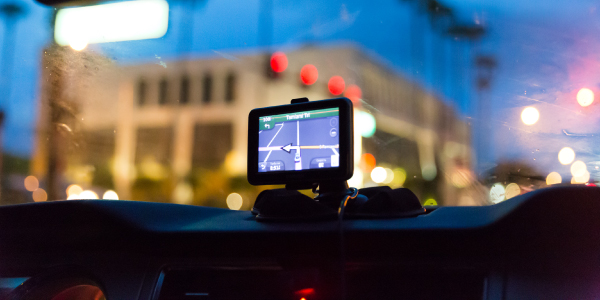5 Benefits of GPS & Location Services Through Cloud Management

In some industries, the advantages of having GPS and location services with Cradlepoint’s Enterprise Cloud Management (ECM) are clear — for instance, companies that dispatch emergency vehicles greatly benefit from GPS-related services. In other industries, however, the power of these tools are less well-known. In reality, GPS and location services can improve a company’s efficiency, service delivery, and bottom line across a wide variety of sectors.
What Is GPS & Location Services with ECM?
GPS and location services essentially allow you and your company to know where your routers are at any given point in time. Being able to locate and track your routers (as well as the equipment, kiosks, and vehicles they reside in) can greatly assist your company in multiple ways.
From a broad perspective, GPS and location services essentially allow your company to answer several basic questions:
- Where are our routers at this moment?
- Where have they been?
- Have they moved?
- Are they secure?
- How are they performing?
Having access to these key pieces of information can help your company’s troubleshooting, business activities, loss prevention, security measures, and overall functionality and efficiency.
What Benefits Do GPS & Location Services Offer?
#1: Troubleshooting
It’s not uncommon in large enterprises for IT teams to lose track of the exact location of key components of the network infrastructure. GPS tracking can save time, money, and headaches by allowing IT administrators to focus on fixing problems both proactively and reactively when they are able to locate, track, and diagnose those problems by site. Time that may have previously been spent trying to determine the exact location of an issue can instead be spent resolving the issue itself.
Troubleshooting in Action — A multistate construction company’s IT department receives a call from a worker at a site, complaining that the network is down. IT traditionally would not know which router the worker is using or where to start to look for problems. However, with GPS and location services, IT staff can ask where the worker is located — a specific building project in Dallas, for example — and then see which router services the worker’s location, see where that router is physically located, and begin running diagnostics remotely.
Troubleshooting can start right away, and the worker does not need to spend time searching for the router that they may not even have physical access to or reading off numbers from the bottom of the device.
#2: Dispatching
Companies that dispatch emergency response, delivery, and other vehicles need to know where those units are at any given time. GPS and location services allow units to be tracked and located quickly and accurately, even if the person or team in the vehicle is too engaged with his or her duties to respond to communicate via phone.
Dispatching in Action — An ambulance company that previously required its emergency vehicles to verbally report their locations via dispatch can now save critical time by letting the in-ambulance router communicate its location automatically. With the ability to know where each and every ambulance is at any moment in time, dispatchers can more quickly route response vehicles to the scenes where they’re most needed, as well as notify hospitals about arrival times.
#3: Tracking
While some companies know and expect their routers to move, others expect them to remain in a specific location — and they need to know if that location changes. GPS and location services help IT and other personnel track their company’s infrastructure and resources. Whether your company is tracking one unit or thousands of units, it’s important to know if they’ve been moved — intentionally or unintentionally — from a location you’ve targeted (and possibly paid for).
Tracking in Action — A DVD rental company pays a premium price to have its product placed in a specific location, such as a kiosk located at the main entrance of a mall or right outside the front doors of a grocery store. If the rental company notices a drastic slip in sales at a certain location, it can use GPS and location services with ECM to determine whether that kiosk has been moved recently. Similarly, a construction company has routers in its trailers at work sites — but those trailers tend to move every few months. IT administrators can always know which routers are in what location without the need for complex reporting procedures from on-site workers every time the trailer relocates to a new project.
#4: Loss Prevention
Some companies may utilize hundreds, thousands, and even hundreds of thousands of routers through their line of business. Requiring employees or contractors to manually track where these routers have been deployed naturally adds human error to the equation. Being able to track where things have been as well as where they are can help with loss prevention and, consequently, can reap substantial cost savings.
Loss Prevention in Action — An Internet provider dispatches hundreds of trucks for customer service, installations, and repairs. Each truck carries routers that are specifically used for business customers that need new service or for current business customers that break/fix service. GPS and location services with ECM can track every single piece of inventory via one pane of glass, eliminating the need for on-site technicians to manually enter and report where each router is placed.
#5: Physical Security (Geofencing)
At times companies and organizations need to know immediately whether one of their routers — or one of the vehicles that houses their routers—has left a particular area. GPS and location services with ECM can immediately alert relevant personnel (such as IT and security teams) when a router has crossed a predetermined geographic boundary. This feature not only ensures the safety of company equipment; it also helps uphold the safety of company employees and contractors.
Physical Security in Action — Using GPS and location services, a city’s police department establishes geofencing for its patrol cars to ensure the safety of its officers. If and when a police unit leaves the predetermined area, the router immediately transmits an alert, thereby informing headquarters that something is amiss with that particular patrol car. Because the unit’s GPS location can be tracked, a response team can be dispatched to investigate, even if the vehicle’s officer can’t be reached via radio or other modes of communication.
Questions / More Information Contact USAT:
For GPS and Location Services Contact a USAT Representative
For Private Networking Data Plans, Learn more about our ExpressM2M service
Share this Post













